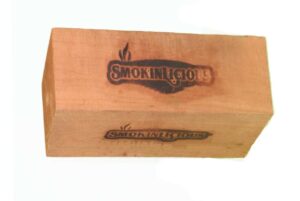
SmokinLicious® Log burns cleaner than Compressed Sawdust
USING COMPRESSED SAWDUST-WHY NOT DO IT OUR WAY? LET’S COUNT THE REASONS!
I read a lot. It is the nature of a scientist. It doesn’t matter if it’s a plant molecular-biology journal article or a cooking/food magazine that is readily available on any newsstand. I love to read and analyze the content. So, when I came upon Bon Appétit’s “Best of 2016” list (September 2016 issue), I was drawn to #11 on the list: a reference to using compressed sawdust blocks for cooking.
Now, if you follow us on our Blog, Flipboard, or our social media platforms, you know our stand on wood used for cooking: no bark ever, only specific hardwoods known to be free of or minimally contain toxins that can accumulate in the human body, use of heartwood only in our manufacturing process, and moisture-rich products so we can control that variable for the specific cooking technique.
I certainly have knowledge of compressed sawdust products used in the heating industry for standard wood stoves and fireplaces, but I had never come across a reference to using them for cooking aside from the pellets commonly used in pellet-style smoker equipment, products that have been around for years. So why did the red flag come up when this reputable magazine referenced a renewable heat product? Because none of these compressed wood product manufacturers ever referenced using the product to cook with. In fact, most stress the use of caution for the intended use in fireplaces and wood stoves, stressing that the BTU level of the product is much higher than standard firewood or cordwood. But let’s take a look at a number of other factors you should weigh before considering these products for the cooking application.
Compressed Sawdust: Most of these companies never reference exactly what woods are used in their manufacturing process. If you know anything about wood-fired cooking you know that ONLY hardwoods should ever be used. Within that group of wood, there are some that are toxic when burned, or when there is exposure to their bark, or even to the sawdust. Of the companies I researched, almost all failed to inform if hardwoods were used exclusively in the manufacturing process. Certainly, there is the risk of a mixture of hard and softwoods. One seller even goes so far as to call their byproduct used “wood waste”.
Low Moisture: There are references by these compressed wood companies that they kiln dry the wood fibers for their process. Again, low moisture levels are great if you plan to use the wood for long heat periods. Remember, the lower the moisture level, the less energy that has to be exerted during combustion of the wood to heat and evaporate the water commonly found in wood. But what happens if you want to control your heat level to say less than 200° F? A high BTU product whose intended purpose is to generate as much heat output as possible may not be the ideal. Even if you are using these blocks in an all-wood unit like a pizza oven, it will take a tempered hand to learn when to feed the fire to ensure the stability of temperature. Even brick, ceramic and clay ovens can crack when heat levels exceed recommended levels.
Flavor: Although there are many out there in the culinary arts that would say that wood-fired cooking is the technique to do these days, I stress that you really need to know the purpose of why you would choose this method of cooking before you jump into it. Yes, you can use some standard cooking equipment to wood-fire cook, including the simple cast iron skillet that can be loaded with wood chips but ask yourself, am I doing this technique merely for the method’s appearance or to produce an unusual and exceptional flavor that is unique to wood-fired cooking? Here’s the controversy: cooking with compressed woods does nothing for flavor if you don’t know the composition of the wood material used to make the compressed wood product! Yes, you will get heat output for the cooking process but in my opinion, you simply can’t get the same flavor because you don’t know what woods are in the brick to feel comfortable balancing out the other ingredients of your dish. I think we can all agree that what makes a memorable meal and a winning dish is not necessarily the complexity of the ingredients or the technique employed, but rather the marriage of all the flavors that register with your senses.
I want as many Chefs, cooks, and culinary enthusiasts to embrace wood-fired cooking but I also feel an obligation to ensure that they have knowledge of what the risks can be and what to look for in a supplier’s product. Yes, storing firewood for kitchen use is not the ideal given firewood’s tendency for attracting bugs, molds, and sometimes rodents. This IS the reason why we’ve always promoted the fact that SmokinLicious® is not a firewood company but a COOKING wood company.
If storage is the only criterion being factored into a wood product selection and purchase for cooking application, then you’re not asking the right questions. compressed brick for Blog
Dr. Smoke- While compressed sawdust is wood, there are chemicals added to bind the sawdust particles together. Adding chemicals to the smoking process! our secrets and we apply this same principle by protecting the customer’s information!
